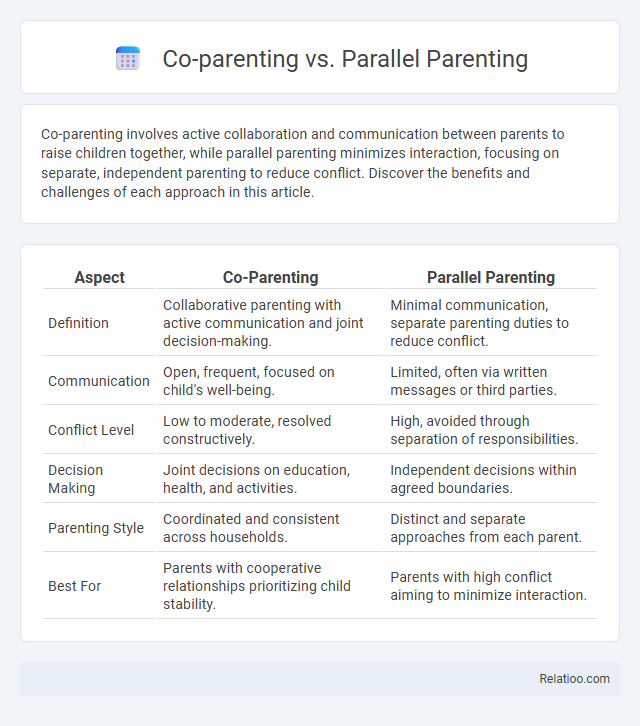Co-parenting involves active collaboration and communication between parents to raise children together, while parallel parenting minimizes interaction, focusing on separate, independent parenting to reduce conflict. Discover the benefits and challenges of each approach in this article.
Table of Comparison
| Aspect | Co-Parenting | Parallel Parenting |
|---|---|---|
| Definition | Collaborative parenting with active communication and joint decision-making. | Minimal communication, separate parenting duties to reduce conflict. |
| Communication | Open, frequent, focused on child's well-being. | Limited, often via written messages or third parties. |
| Conflict Level | Low to moderate, resolved constructively. | High, avoided through separation of responsibilities. |
| Decision Making | Joint decisions on education, health, and activities. | Independent decisions within agreed boundaries. |
| Parenting Style | Coordinated and consistent across households. | Distinct and separate approaches from each parent. |
| Best For | Parents with cooperative relationships prioritizing child stability. | Parents with high conflict aiming to minimize interaction. |
Understanding Co-Parenting and Parallel Parenting
Co-parenting involves actively collaborating with your ex-partner to raise children, prioritizing open communication and joint decision-making that supports family cohesion. Parallel parenting reduces direct interaction, allowing each parent to independently manage their responsibilities, minimizing conflict while maintaining stability for your children. Understanding these approaches helps you choose the best strategy for fostering a supportive environment tailored to your family's unique dynamics.
Key Differences Between Co-Parenting and Parallel Parenting
Co-parenting involves active collaboration and communication between parents to jointly raise their children, prioritizing the child's well-being in a harmonious environment. Parallel parenting reduces direct interaction, with parents focusing on set boundaries and independent decision-making to minimize conflict, often used when cooperation is challenging. Understanding these distinctions helps you choose the best approach to support family cohesion and maintain a stable upbringing for your children.
Benefits of Co-Parenting for Children
Co-parenting fosters consistent communication and cooperative decision-making, promoting emotional stability and a strong sense of security for children. Unlike parallel parenting, which limits interaction between parents to reduce conflict, co-parenting actively involves both parents in shared responsibilities and nurturing, contributing to healthier child development. Enhanced family cohesion through co-parenting supports improved social skills and resilience in children by providing a unified and supportive family environment.
Advantages of Parallel Parenting in High-Conflict Situations
Parallel parenting minimizes direct interaction between high-conflict parents, reducing opportunities for disputes and emotional stress, which benefits the child's stability and well-being. Your involvement remains structured but separate, allowing both parents to fulfill responsibilities without escalating tension. Family cohesion improves as parallel parenting creates a calmer environment, promoting consistent routines and clear boundaries critical for healthy child development.
Communication Styles in Co-Parenting vs Parallel Parenting
Effective communication in co-parenting involves open, cooperative dialogue focused on the child's well-being, promoting mutual respect and flexibility between parents. In contrast, parallel parenting relies on limited, structured communication to minimize conflict, where interactions are often restricted to essential information exchange. Your choice between these styles impacts family cohesion, as co-parenting fosters emotional connection while parallel parenting prioritizes stability through reduced interpersonal tension.
Setting Boundaries and Responsibilities
Setting boundaries and responsibilities is crucial in co-parenting, where mutual communication ensures consistent parenting approaches and shared decision-making for Your child's well-being. Parallel parenting emphasizes clear, structured boundaries with minimal direct interaction, allowing separated parents to reduce conflict while maintaining individual responsibilities. Family cohesion thrives when boundaries are balanced with collaboration, fostering an environment where responsibilities are shared, and emotional connections strengthen for holistic family stability.
Impact on Child Development
Co-parenting fosters open communication and collaboration between parents, promoting a stable emotional environment that supports positive child development and social skills. Parallel parenting reduces conflict by limiting direct interaction between parents, which can minimize stress for children but may also lead to inconsistent discipline and emotional confusion. Family cohesion strengthens bonds and provides emotional security, enhancing resilience and cognitive growth in children through consistent support and nurturing relationships.
Transitioning from Co-Parenting to Parallel Parenting
Transitioning from co-parenting to parallel parenting often occurs when communication between parents becomes strained, necessitating a focus on minimizing contact to reduce conflict. Your primary goal should shift to creating clear boundaries and separate responsibilities, ensuring that both parents remain actively involved in the child's life while maintaining emotional stability. Family cohesion can be preserved by prioritizing the child's well-being and stability in both households despite the change in parenting styles.
Tips for Successful Co-Parenting
Effective communication and consistent routines are crucial for successful co-parenting, helping both parents prioritize the child's well-being. Establishing clear boundaries and maintaining mutual respect reduce conflicts and promote stability in parallel parenting arrangements. Encouraging family cohesion involves shared decision-making and supporting positive interactions to strengthen emotional bonds among all family members.
Choosing the Best Parenting Approach for Your Family
Choosing the best parenting approach for your family depends on the level of communication and conflict between parents. Co-parenting fosters collaboration and open dialogue, ideal for parents who can work together effectively, while parallel parenting minimizes interaction, suitable for high-conflict situations. Family cohesion is strengthened when a consistent and respectful parenting strategy is applied, ensuring your children experience stability and emotional security.

Infographic: Co-parenting vs Parallel parenting
 relatioo.com
relatioo.com